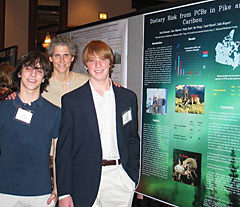What’s in Your Dinner?
Where do UMBC graduate research and local high school students meet? Over slices of caribou.
Mix together graduate students from UMBC’s civil and environmental engineering department (CEE), samples of pike and caribou from the Arctic, and a handful of inquisitive high school students, and you get one big prize: The Best Poster Award at the annual meeting of the International Society for Risk Analysis (SRA). The SRA is more than your average high school science fair. This unique group of students was competing with other Ph.D. students at an internationally recognized competition.
In 2009, Upal Ghosh, CEE associate professor and graduate program director, was already deep into a study with the Maryland Department of the Environment when he was approached by Julie Rogers, a Park High School teacher, about a partnership. Rogers was taking a trip to the Arctic Research Center and wanted to bring back a few wildlife samples for her students to analyze, but needed some help from the UMBC labs.
Piggy backing on the study already in progress with the UMBC CEE program, both sets of students combined forces. The high school students were responsible for designing the study (goals, questionnaire, plans for sample shipping) and getting approvals. In addition, they used the data generated from the samples to conduct a human health risk assessment. The UMBC graduate students were responsible for the lab work, analysis, data, and project oversight. All of this combined would help to determine if there were hazardous legacy chemicals present in Arctic samples. Legacy chemicals are ones that may take more than 30-40 years to enter into the food supply depending on how they move through the environment. The Inuit tribes may be ingesting chemicals from wildlife that may have taken 40 years to get there, but might be immediately dangerous to their health.
Although the analysis found that there were no chemicals present in the samples of fish and caribou collected, both sets of students found the study especially rewarding. Ghosh is excited about an opportunity to continue to pursue research collaborations with his graduate school students and high school students. Piuly Paul, one of the CEE graduate students, was especially excited about the collaboration. Paul explains, “You could show the high schoolers what we do in a graduate lab. It was exciting to see the curiosity that you generate in them. ”
Through a combined learning experience, the UMBC graduate students were able to expand their study of the Chesapeake Bay fish to the arctic. The Park high-schoolers got to partake in research that won them a major award and observe real research students in a real lab. Josh Naiman, one of the Park High School seniors, says, “It was a rewarding experience working with grad school students.” He hasn’t officially decided if environmental science is where he is heading, but this experience has him strongly considering it.
While these collaborations provide great opportunities, it’s the efforts of these students to keep our waters, and dinner, safe that really matters.
(4/2/10)

